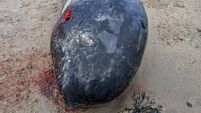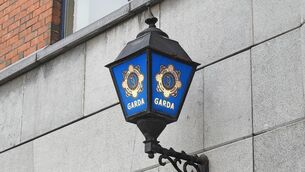Wild Irish venison an ethical, healthy alternative to processed meats

A Sika deer in North Cork. Growth in the country's deer population means a plentiful supply, and a new drive to see wild venison as a sustainable and healthy option and an alternative to intensely produced meat is gaining ground. Picture: Dan Linehan
Once the meat of kings and chieftains — medieval and renaissance literature is peppered with references to the fine straps and haunches of deer enjoyed by the aristocracy in Ireland — wild venison has to date failed to capture the modern Irish imagination.
But that could all change.
Growth in the country's deer population means a plentiful supply, and a new drive to see wild venison as a sustainable and healthy option and an alternative to intensely produced meat is gaining ground. The recent spate of bird flu outbreaks may also see some consumers seeking turkey alternatives this Christmas.
Already, a number of supermarket chains — most notably the German discounters Aldi and Lidl — are offering Irish wild venison steak and fresh venison roasting joint as part of their festive menus.
More restaurants, too, seem to be offering local venison this season, particularly in Munster.
Kerry chef Paul Treyvaud, based in Killarney, describes wild Irish venison as “a stunning piece of meat”.
He has served venison on his Christmas menu for more than two decades and will have it again this year on the menu in Treyvaud's in Killarney. But he acknowledges that there is a reluctance among Irish people to cook venison.
However the chef believes that “more and more, Irish people should be cooking it.”
For people new to venison, his advice is simple — "You cook it exactly the same as steak."
The backstrap or sirloin of venison is cooked exactly the same as beef sirloin — sealed in a red hot pan and served medium. The haunch is like the back leg of lamb. It does more work than the strap, he says, and is therefore more muscley, but with a little bit of care it comes up beautifully too.
“It is incredibly tender meat,” said Paul. “The flavour of Irish venison is second to none."
Treyvaud's wild Irish venison is sourced through registered suppliers. And Paul stresses that when we speak of Irish venison it is “the non-indigenous” deer — sika introduced in the 19th century and fallow brought in by the Normans, for hunting and eating — not the native Killarney Reds, Paul cautions.
The Irish Deer Society, established in 1968 and concerned with the welfare of wild deer, also believes venison is a sustainable and indeed ethical choice.
“Venison is a protein source that’s not only rich in nutrients but also has a significantly lower environmental footprint compared to traditional livestock. Choosing venison is more than a culinary decision — it’s a step toward a more sustainable, ethical, and environmentally responsible food system,” the society said.
It is also “exceptionally healthy” — leaner than beef, high in protein, packed with essential nutrients such as iron, zinc, and B vitamins, and is low fat.

When hunted ethically and locally, deer can be harvested with minimal stress and encourages a local and seasonal food system.
But changing consumers' attitudes towards venison remains a big challenge.
Documents released under the Freedom of Information Act by the Irish Deer Management Strategy Group, set up to by the Government to develop a national strategy for deer, said the big barrier is attitude.
“Irish people don’t eat venison — it's seen as expensive, elite meat, difficult to cook and very strong tasting,” is one of the conclusions of the management group.
Hunters, game handlers, Bord Bia, and chefs all need to be involved to help promote it, the group recommends.
There are a number of references in the documents to developing the meat for the pet food industry, something that concerns the Irish Deer Commission, the hunters, and deer management conservation body, which obtained the documents.
Deer management needs have to go hand-in-hand with a strong venison market, Damien Hannigan of the Irish Deer Commission said.
“Venison is a high-value meat and will complement our existing meat industry, any attempt to downgrade venison as a secondary meat will have negative consequences for deer management,” the commission said in their submission to a public consultation on deer.
Around 55,000 deer are culled in Ireland each year now — mostly in Wicklow, Tipperary, West Cork, Waterford, Galway, and Kerry.
The market for processed venison here is relatively small, with most of what the hunters take out in culls either eaten by themselves or sent in fur to the UK to be processed by approved game-handling establishments.
Europe, where there is demand for venison, would be an ideal market for wild Irish venison, Mr Hannigan said.
A survey by the IDC found that 81% of respondents believe the Government should do more to develop the wild venison market in Ireland.
Changes also need to be made in setting up larders locally and establish a system to make it easier for licensed hunters to sell deer carcasses directly to restaurants and butchers — similar to what happens in Scotland.
Kerry Wild Game, a venison supplier and processing business was established in Killorglin in 2020 by Jerome Cahill. It now takes in deer carcasses from across Munster.

A hunter himself, he ensures the carcasses he receives are shot properly and cleanly. His is a fully licensed wild game operation inspected by the Department of Agriculture. His focus is the domestic market, supplying more than a dozen restaurants including a Michelin-star restaurant in Clare.
Starting four years ago he supplied just two hotels. Last year he was able to open all year round.
“I saw the opportunity,” Jerome said.
The venison market, however, needs to be supported by better food promotion and State agencies.
Often people's idea of venison comes from being given whatever the hunter does not want and gives to neighbours and the impression of venison is tough and strong, Jerome said. But this is not the case when it is properly hung and processed.
Bord Bia, the Irish food development and promotion board, told the while venison remains “a niche element of overall meat production", recent developments indicate there is potential growth.
Engagement with the small number of companies in Ireland which process and export venison has indicated that key export opportunities exist in central Europe, particularly in Germany, the food board said.
"The lack of a traceability system or quality assurance standards, limits to some extent what we can do, however from a business expansion perspective Bord Bia will continue to engage with relevant companies and invest in identifying and supporting domestic and export market opportunities for Irish venison as appropriate,” it said.










